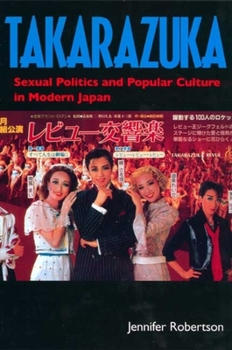Takarazuka: Sexual Politics and Popular Culture in Modern Japan
Select Format
Select Condition 
Book Overview
The all-female Takarazuka Revue is world-famous today for its rococo musical productions, including gender-bending love stories, torridly romantic liaisons in foreign settings, and fanatically devoted fans. But that is only a small part of its complicated and complicit performance history. In this sophisticated and historically grounded analysis, anthropologist Jennifer Robertson draws from over a decade of fieldwork and archival research to explore...
Format:Paperback
Language:English
ISBN:0520211510
ISBN13:9780520211513
Release Date:July 1998
Publisher:University of California Press
Length:320 Pages
Weight:1.10 lbs.
Dimensions:0.7" x 6.1" x 9.0"
Customer Reviews
3 ratings
An Academic Look at Girls Playing at Being Boys
Published by Thriftbooks.com User , 17 years ago
The Takarazuka Kagekidan (usually referred to in English as the Takarazuka Revue) has almost as many official publications as the Chinese Communist Party. Most of the information available about the famous all-female theatre troupe has been thoroughly blue-pencilled by the revue administration before being disseminated to its leagues of fans. Kobayashi Ichiyo, founder of the Hankyu Railway and the man behind Takarazuka, promoted the revue as wholesome family entertainment. He would do back-flips in his grave if he were to discover that his beloved Takarasiennes were the subject of a book on gender and sexuality. The Hankyu-Toho fortress is hard to penetrate. A recent publication on Godzilla was subtitled "The book that Toho doesn't want you to read." One Takarazuka fan warned Jennifer Robertson during her research, "[The Takarazuka administration] is mean. They have their ways. They could twist your arm the way developers do when they want you to sell land." Undeterred, Prof. Robertson has succeeded not only in demystifying the revue but also in framing it against the background of Japan's turbulent sexual politics. Interest in the revue in the West has been limited until recently and even then it was Takarazuka's curious sexuality was the focus of attention. When Takarazuka performed in London in 1994, members of the city's gay community filled the houses. A documentary film on the revue from the same year, Dream Girls, directed by Kim Longinotto and Jano Williams, is a homosexual interpretation of the revue that has been shown widely at lesbian and gay film festivals. Robertson's interpretation is not so simplistic, nor is there any of the underlying sarcasm of Dream Girls. Indeed it is obvious that she is a fan. "I was hooked," she writes, "not by the retrograde, if steamy, sexual politics of the story, but by the mostly female audience whose intense absorption in the wrenching action made the auditorium sizzle with eroticized energy." The key chapters of the book, "Staging Androgyny" and "Performing Empire" are re-workings of Robertson's articles previously published in American Ethnologist. In "Staging Androgyny," Robertson examines the imprecise nature of gender in Japanese theatre and a history of cross-dressing. She also looks at how this is reflected in Japanese society as a whole. More importantly, she draws the distinction between sex (i.e. the sexual act) and gender, somewhat strengthening the argument of Takarazuka as wholesome entertainment. (Guardian critic Michael Billington, for example, dubbed their London performance "curiously sexless"). "Performing Empire" offers a fascinating insight into wartime Japan when Takarasiennes dressed in khaki and theatregoers could enjoy such spectacles as Made in Nippon and The Children of East Asia. That a bastion of chintz and glitter could work as a propaganda machine would seem unrealistic until you discover that the revue's founder served as a member of the cabinet in the 1940s. Roberst
Robertson's Revue of Japanese Sex Politics Deserves a Standing Ovation
Published by Thriftbooks.com User , 17 years ago
Jennifer Robertson attempts to use the all-female Takarazuka theater revue as a model for the sexual politics and gender relations present in modern Japanese society. Robertson does this by looking at overlapping discussions of sexuality, gender roles, popular culture, Japanese fan culture, and Japanese national identity as these aspects are portrayed by the Takarazuka Revue. Robertson discusses taboo subjects like cross-dressing and lesbianism, and forms of public gender performance in theater and popular culture in order to dismantle cultural stereotypes of Japanese women and men. The important idea that I believe Robertson is trying to express in this ethnography is that gender and sexuality are not monolithic nor are male and female distinct categories. In fact, sexuality and gender are constantly being redefined through history and are therefore more fluid in nature. If you are at all interested in gender relations, alternative gender roles, Japanese culture, or female theater this book will surely entertain and enlighten you.
amazing
Published by Thriftbooks.com User , 23 years ago
The mere fact that the author puts so much effort into examining sexuality and androgeny in Japan is commendable. The book gives a lot of insight to Sexuality in Japan (mostly 2oth C.) through her analysis of the all-female Takarazuka Revue founded in 1919.Chapters include (1) Ambivalence and Popular Culture; (2) Staging Androgeny; (3) Performing Empire; (4) Fan Pathology; (5) Writing Fans. Chapters 1,2 and 3 I thought were particularly well-written and informative. Robertson does a great job examining gender roles and performances that are often very permeable (despite the fact that many people are in delian of this). great book.






